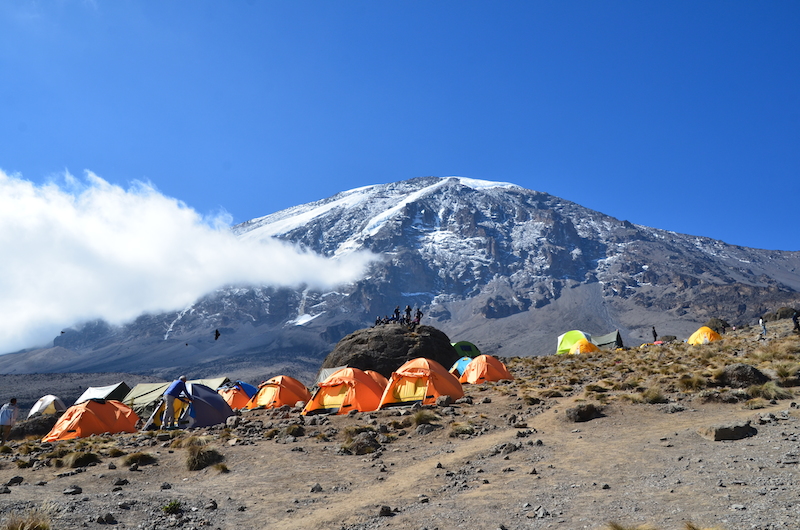
Every now and then we like to deny ourselves of something that we like. We tend to torture ourselves with diets, gym regiments, plastic surgeries, bad relationships, boring jobs, etc.
My own version of an elaborate and extensive self-denial came in the way of organizing and participating in a seven-day trek up and down Mt. Kilimanjaro. Our team was aptly named “The Kili Crew” and consisted of myself, both of my sons and 10 male friends.
A lot of preparation went into making this trip possible and I was fully aware of how many things I would be denying myself during this adventure. Nevertheless, one thing is to imagine how difficult something like this would be, but it is completely different to actually face the difficulties, which we had actually encountered in August of 2014.
Mt. Kilimanjaro exceeds 19,000 feet and is known as the “Roof of Africa”. However, it takes a few days of hiking and camping in the “bush” in order to reach the base camp, from which we could attempt to get to the summit.
Obviously, we knew that it would be extremely difficult to hike at the increasingly high altitude and withstand all kinds of discomfort and health challenges that are typical in these adverse conditions. Surprisingly, all of the above turned out to be very manageable, mostly thanks to the skill and restless efforts of our Tanzanian guides, cooks and porters. As usual, behind every successful explorer there is a small army of anonymous assistants!
However, the camping way of life, which we had to adopt on day 1 of our expedition, turned out to be a lot less bearable. As soon as we crossed the Machame Gate into Kilimanjaro National Park and during 7 days that followed, we had to live without the entire range of things that most of us take for granted. Allow me to recount the most obvious ones:
- There was no running water whatsoever. The porters had to carry some water on their heads and get the rest from a few streams on the mountains, but only so much of it could be brought into every campsite.
- This meant that we had to forgo washing ourselves. It was still possible to wash one’s hands and face as well as brush the teeth, but that was about it. In order to mitigate this unpleasant situation, we had deployed all kinds of “dry” washing and wiping alternatives, which were developed for the military field units and the astronauts, but they proved to be a very inadequate substitute to a shower or even a simple bucket of cold water emptied over one’s head.
- Shaving became virtually impossible and most of us started to brandish newly grown mountaineering beards, while seriously considering keeping them upon our glorious return home.
- All forms of modern plumbing were ruled out from the get-go, which meant having to line up in front of a wooden outhouse and do your business over a tiny (!) hole in the floor. I will spare your sensitivities and refrain from describing the sharpshooting “dis”-ability of most people, who are no longer accustomed to this form of ancient exercise. One of the most effective jokes during the hike became a package of disposable toilet seat covers, which I brought from home. Clearly, there was no practical use for this contraption.
- Additionally, the strong mountain winds, almost complete lack of vegetation and constant foot traffic would raise clouds of dust, which found its way into every part of our bodies, food and gear.
- Our sense of smell, which during our normal lives used to be pretty fussy, had no choice but to surrender for all practical purposes. Even though our small group still managed to retain some form of acceptable look and smell, the same could not be said of hundreds of porters that had often surrounded us on our hikes and climbs.
- We also had to harvest the electric energy via our personal solar panels, which we had carried attached to our backpacks. The results were mixed, at best, given the fact that we had often hiked inside the clouds or were covered by the deep shadows from the mountain ranges.
- We were cold! On most nights the temperature in our tents would drop to 0 degrees C, or 32 degrees F. Even the our warmest sleeping bags and the thermal underwear did not provide the desired warmth. The roof of our tents would turn into a solid sheet of ice and it was very uncomfortable to even think about leaving the tent in the middle of the night or in the morning. The only source of reliable warmth was the Sun and we were anxiously awaiting 6:30 – 7 AM when the sun would rise over the mountain ridge and warm us up!
Last, but not least, we were almost completely cutoff from the outside world. Our cell phones were as useful as bricks, with the exception of a few spots from which we could send a text message to the loved ones but, for some strange reason, get no reply.
To summarize, while hiking and even breathing on the Mountain was challenging enough, having lost the usual creature-comforts of our homes and the proximity of our loved ones was the most taxing for us.
No matter – we were willing to soldier on through these and other inconveniences and even made peace with them. This proved to be the smartest thing to do – once we accepted the harsh realities they had, sort of, stopped being that important to us.
Of course, all of the discomforts described earlier were just a prelude to the real challenges that were waiting for us on the dreaded Summit Day. But that, my friends, is a completely different story…
Igor Yasno
Kilimanjaro Photo Album